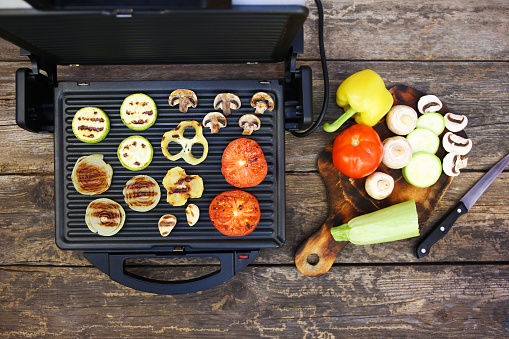With summer well and truly behind us and winter just on the horizon, you may be thinking that your grilling days are done for another year. Now, this may be true if you’re thinking of having BBQs outside, but indoor grilling is always an option, no matter what the weather throws at us.
Indoor grilling isn’t just a case of dragging your BBQ into the house though. That would be very silly, and incredibly dangerous. The open flames, plus the smoke and fumes that make those burgers and steaks taste so good in the garden, can be deadly when trapped indoors.
So, how do you go about indoor grilling?
Well, we are here to tell you all you need to know, and steer you away from making some common mistakes. Let’s get cracking on, shall we?
Indoor grilling: What you’ll need
To safely grill indoors, you’re going to have to spend a few pennies on the right equipment. Thankfully, you only really need a grill that is designed for indoor use, and they are easy to come by.
You have three main options for indoor grilling, a grill pan, a folding grill, and a flat open grill. Grill pans often have ridges in the middle of them, and they can be used just like any other cooking pan: simply stick them on the hob and get to work. If you’re going to buy a grill pan, go for a cast iron one as they heat up, and stay hot better than other materials.

The second option is to buy a folding indoor grill. These are very popular these days for a number of reasons. Firstly, they allow you to cook both sides of your food at the same time, which obviously cuts down on cooking times, and secondly, they are usually designed to be easy to clean, and quite compact. The downside to these folding indoor grills, is that they are only really good for cooking enough food for a few people due to their compact nature.
Open grills are the best choice for cooking for large families as the flat cooking surface can hold a lot more food at the same time. The problem with these though, is you need quite a bit of space in the kitchen to use one safely and comfortably, and they don’t cook both sides at once like a folding grill can.
Article you might like:
- 5 Wonderful Winter Plants to Brighten Up Your Garden
- Growing Herbs in Pots UK
- Quick gardening breaks – Working at home
Indoor grilling: Will there be a lot of smoke?
When you are grilling, there will nearly always be some kind of smoke, but electric indoor grills produce considerably less than any charcoal grill, with some models producing hardly any at all thanks to built-in features such as extractor fans. I would advise that you clean your indoor grill thoroughly after each use, as it is the old grease and pieces of food left on the grill that burns and starts to smoke.
If you have a model that does produce more smoke than you are happy with, you should use it in a well ventilated room, preferably near an open window or door. Alternatively, you could use the kitchen extractor fan if you have one. Your pan should not be smoking before you add any food. If it is, it is a sign that it is too hot. The fat on your pieces of meat can also create smoke, so for indoor grilling, it is best to trim it off
Indoor grilling: How to prevent burning
One of the best ways to prevent your food from burning, whether it is meat or vegetables, is to season and marinate them first. However, if your marinade has large pieces of garlic, herbs, or similar, they might burn on the grill, so grab a brush and coat the food in a little oil to prevent this happening.
A nice mix of some kind of citrus juice like lemon or lime, and olive oil makes a perfect vegetable marinade for indoor grilling, stopping the veggies burning too quickly and also adding some delicious flavour.
Simply seasoning with salt, pepper, and maybe a little thyme is really all you need for chicken and steaks, but make sure that your meats don’t have excess moisture before putting them on the grill. A simple patting down with a kitchen roll works really well.
I recommend getting your grill nice and hot, but then turning the heat down a few notches to medium or even medium-low to actually do the cooking, and this should prevent most of the burning.
Indoor grilling: Is it healthier?
Despite makers of indoor grills claiming them to be healthier than charcoal grills, especially the folding grill models, there is actually no evidence that they are any healthier. You are still cooking meat, and there are still fats that go along with that, so don’t buy one of these because you think it’ll help with your diet. Having said that, they are not unhealthier either.
Indoor grilling: Can I get that ‘smoky’ taste?
Yes and no. It is extremely difficult to replicate the taste you get from charcoal barbecue, but there are some things you can try to get closer to it, if that’s your aim. For example, there are rubs and herbs that you can buy from the supermarket that are designed to help give your food a more smoky flavour, and you can always get some nice, smoky barbecue sauce. As you can see, the colder weather doesn’t have to mean you can’t enjoy some freshly grilled dishes like shish kebabs, burgers, steaks, and juicy chicken.

Always read the instructions on any indoor grill that you are going to use, and follow the safety guidelines carefully to ensure that there are no unnecessary accidents. As already mentioned, use your indoor grill in a well ventilated place, be careful not to have the heat too high all the time, and be sure to keep your grill clean to avoid too much smoke. Seasoning and marinating can also reduce the risk of excessive smoke, as can oiling the grill.
